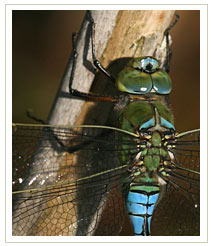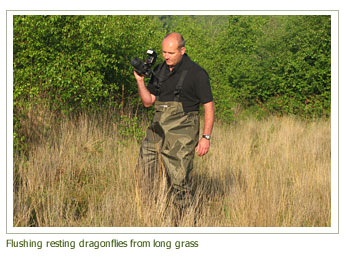
 |
The Flush and Stalk Technique The remarkable thing about resting Emperors, is their ability to blend in to their surroundings despite their vivid blue body. I have walked through ferns and heather in the Forest and had male Emperors constantly taking to the air from just one or two feet in front of me, although they were practically invisible to the passer by. It was this ‘flushing’ behaviour that led to the discovery of this technique. Firstly you need to be in an area of ferns or heather that is flanking a body of water (streams or small ponds work best). Be sure that there is plenty of dragonfly activity in the air above your intended site. Next walk through the foliage, brush your legs against the heather / ferns (being careful not to cause any damage). As soon as a dragonfly takes to the air, maintain eye contact on the target until it lands again. Usually it will land quite quickly, and invariably the landing spot will be between 5 and 20 feet away from its original location. |
||||
|
Now comes the tricky part. You will need to keep your eye trained on the spot where the Dragonfly landed for the time it takes for you to slowly stalk up to its position. Sometimes you will loose site of the dragonfly once landed, this is not a problem, keep your attention focussed on the piece of foliage where it was last seen The approach should now be very slow and quite, getting slower as you get within 10 feet of the insect. Your final steps should be taken in a crouched position, with no more than one step every 5-10 seconds. You should start photographing the dragonfly now. Don’t wait until you have that perfect spot that is just 3 feet from the target. If you start photographing at 10 feet you may still walk away with a good photograph, that with a high enough pixel count can be cropped to achieve good results. Each step you get closer take another photograph, until eventually you end up with a succession of increasingly detailed shots before the dragonfly takes to the air. This serves two purposes, firstly each time you pause to take a photograph the dragonfly will relax and is less likely to be startled, and secondly you will walk away with something to show, even if the dragonfly becomes airborne before you got to the optimum position. |
 |
||||